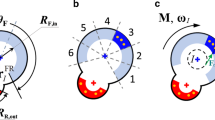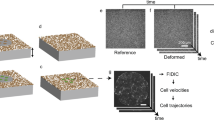Abstract
Collective cell migration is regulated by a complex set of mechanical interactions and cellular mechanisms. Collective migration emerges from mechanisms occurring at single cell level, involving processes like contraction, polymerization and depolymerization, of cell–cell interactions and of cell–substrate adhesion. Here, we present a computational framework which simulates the dynamics of this emergent behavior conditioned by substrates with stiffness gradients. The computational model reproduces the cell’s ability to move toward the stiffer part of the substrate, process known as durotaxis. It combines the continuous formulation of truss elements and a particle-based approach to simulate the dynamics of cell–matrix adhesions and cell–cell interactions. Using this hybrid approach, researchers can quickly create a quantitative model to understand the regulatory role of different mechanical conditions on the dynamics of collective cell migration. Our model shows that durotaxis occurs due to the ability of cells to deform the substrate more in the part of lower stiffness than in the stiffer part. This effect explains why cell collective movement is more effective than single cell movement in stiffness gradient conditions. In addition, we numerically evaluate how gradient stiffness properties, cell monolayer size and force transmission between cells and extracellular matrix are crucial in regulating durotaxis.










Similar content being viewed by others
References
Allena R, Scianna M, Preziosi L (2016) A Cellular Potts model of single cell migration in presence of durotaxis. Math Biosci 275:57–70. https://doi.org/10.1016/j.mbs.2016.02.011
Aman A, Piotrowski T (2010) Cell migration during morphogenesis. Dev Biol 341:20–33. https://doi.org/10.1016/j.ydbio.2009.11.014
Ananthakrishnan R, Ehrlicher A (2007) The forces behind cell movement. Int J Biol Sci 3:303–317. https://doi.org/10.7150/ijbs.3.303
Bonet J, Wood RD (2008) Nonlinear continuum mechanics for finite element analysis. Cambridge University Press, Cambridge
Bookholt FD, Monsuur HN, Gibbs S, Vermolen FJ (2016) Mathematical modelling of angiogenesis using continuous cell-based models. Biomech Model Mechanobiol 15:1577–1600. https://doi.org/10.1007/s10237-016-0784-3
Boon WM, Koppenol DC, Vermolen FJ (2016) A multi-agent cell-based model for wound contraction. J Biomech 49:1388–1401. https://doi.org/10.1016/j.jbiomech.2015.11.058
Camley B, Rappel W-J (2017) Physical models of collective cell motility: from cell to tissue. J Phys D Appl Phys 50:113002. https://doi.org/10.1088/1361-6463/aa56fe
Camley BA, Zhang Y, Zhao Y et al (2014) Polarity mechanisms such as contact inhibition of locomotion regulate persistent rotational motion of mammalian cells on micropatterns. Proc Natl Acad Sci 111:14770–14775. https://doi.org/10.1073/pnas.1414498111
Chan CE, Odde DJ (2008) Traction dynamics of filopodia on compliant substrates. Science 322:1687–1691
Chen J, Weihs D, Vermolen FJ (2017) A model for cell migration in non-isotropic fibrin networks with an application to pancreatic tumor islets. Biomech Model Mechanobiol. https://doi.org/10.1007/s10237-017-0966-7
Cherry JL, Adler FR (2000) How to make a biological switch. J Theor Biol 203:117–133. https://doi.org/10.1006/jtbi.2000.1068
Cochet-Escartin O, Ranft J, Silberzan P, Marcq P (2014) Border forces and friction control epithelial closure dynamics. Biophys J 106:65–73. https://doi.org/10.1016/j.bpj.2013.11.015
Collins JJ, Gardner TS, Cantor CR (2000) Construction of a genetic toggle switch in Escherichia coli. Nature 403:339–342. https://doi.org/10.1038/35002131
Condor M, Garcia-Aznar JM (2017) A phenomenological cohesive model for the macroscopic simulation of cell-matrix adhesions. Biomech Model Mechanobiol. https://doi.org/10.1007/s10237-017-0883-9
Del Amo C, Borau C, Movilla N et al (2017) Quantifying 3D chemotaxis in microfluidic-based chips with step gradients of collagen hydrogel concentrations. Integr Biol 9:339–349. https://doi.org/10.1039/C7IB00022G
Dokukina IV, Gracheva ME (2010) A model of fibroblast motility on substrates with different rigidities. Biophys J 98:2794–2803. https://doi.org/10.1016/j.bpj.2010.03.026
Doyle PS, Shaqfeh ESG, Gast AP (1997) Dynamic simulation of freely draining flexible polymers in steady linear flows. J Fluid Mech 334:251–291. https://doi.org/10.1017/S0022112096004302
Drasdo D, Hoehme S (2012) Modeling the impact of granular embedding media, and pulling versus pushing cells on growing cell clones. New J Phys. https://doi.org/10.1088/1367-2630/14/5/055026
Elosegui-Artola A, Bazellières E, Allen MD et al (2014) Rigidity sensing and adaptation through regulation of integrin types. Nat Mater 13:631–7. https://doi.org/10.1038/nmat3960
Elosegui-Artola A, Oria R, Chen Y et al (2016) Mechanical regulation of a molecular clutch defines force transmission and transduction in response to matrix rigidity. Nat Cell Biol 18:540–548. https://doi.org/10.1038/ncb3336
Escribano J, Sánchez MT, García-Aznar JM (2014) A discrete approach for modeling cell-matrix adhesions. Comput Part Mech 1:117–130. https://doi.org/10.1007/s40571-014-0006-7
Escribano J, Sanchez MT, Garcıa-Aznar JM (2015) Modeling the formation of cell-matrix adhesions in 3D matrices. J Theor Biol 384:84–94. https://doi.org/10.1016/j.jtbi.2015.07.015
Gardel ML, Sabass B, Ji L et al (2008) Traction stress in focal adhesions correlates biphasically with actin retrograde fl ow speed. J Cell Biol 183:999–1005. https://doi.org/10.1083/jcb.200810060
Gonzalez-Valverde I, Garcia-Aznar JM (2017) A hybrid computational model to explore the topological characteristics of epithelial tissues. Int J Numer Method Biomed Eng. https://doi.org/10.1002/cnm.2877
Haeger A, Wolf K, Zegers MM, Friedl P (2015) Collective cell migration: guidance principles and hierarchies. Trends Cell Biol 25:556–566. https://doi.org/10.1016/j.tcb.2015.06.003
Hartman CD, Isenberg BC, Chua SG, Wong JY (2016) Vascular smooth muscle cell durotaxis depends on extracellular matrix composition. Proc Natl Acad Sci U S A 113:11190–11195. https://doi.org/10.1073/pnas.1611324113
Hughes TJR (1987) The finite element method: linear static and dynamic finite element analysis, vol 825. Prentice-Hall, Inc, Englewood Cliffs
Hughes TJR (2012) The finite element method: linear static and dynamic finite element analysis. Courier Corporation, North Chelmsford
Jia D, Jolly MK, Boareto M et al (2015) OVOL guides the epithelial-hybrid-mesenchymal transition. Oncotarget 6:15436–15448. https://doi.org/10.18632/oncotarget.3623
Kabla AJ (2012) Collective cell migration: leadership, invasion and segregation. J R Soc Interface 9(77):3268–3278. https://doi.org/10.1098/rsif.2012.0448
Kanchanawong P, Shtengel G, Pasapera AM et al (2010) Nanoscale architecture of integrin-based cell adhesions. Nature 468:580–4. https://doi.org/10.1038/nature09621
Kim T, Hwang W, Kamm RD (2007) Computational analysis of a cross-linked actin-like network. Exp Mech 49:91–104
Kim MC, Whisler J, Silberberg YR et al (2015) Cell invasion dynamics into a three dimensional extracellular matrix fibre network. PLoS Comput Biol 11:1–29. https://doi.org/10.1371/journal.pcbi.1004535
Kong F, García AJ, Mould aP et al (2009) Demonstration of catch bonds between an integrin and its ligand. J Cell Biol 185:1275–84. https://doi.org/10.1083/jcb.200810002
Kulawiak DA, Camley BA, Rappel W-J (2016) Modeling contact inhibition of locomotion of colliding cells migrating on micropatterned substrates. PLoS Comput Biol 12(12):1–25. https://doi.org/10.1371/journal.pcbi.1005239
Lang NR, Skodzek K, Hurst S et al (2015) Biphasic response of cell invasion to matrix stiffness in three-dimensional biopolymer networks. Acta Biomater 13:61–67. https://doi.org/10.1016/j.actbio.2014.11.003
Leong FY (2013) Physical explanation of coupled cell-cell rotational behavior and interfacial morphology: a particle dynamics model. Biophys J 105:2301–2311. https://doi.org/10.1016/j.bpj.2013.09.051
Lin S-Z, Li B, Xu G-K, Feng X-Q (2016) Collective dynamics of cancer cells confined in a confluent monolayer of normal cells. J Biomech 52:140–147. https://doi.org/10.1016/j.jbiomech.2016.12.035
Liu F, Mih JD, Shea BS et al (2010) Feedback amplification of fibrosis through matrix stiffening and COX-2 suppression. J Cell Biol 190:693–706. https://doi.org/10.1083/jcb.201004082
Majumdar R, Sixt M, Parent CA (2014) New paradigms in the establishment and maintenance of gradients during directed cell migration. Curr Opin Cell Biol 30:33–40. https://doi.org/10.1016/j.ceb.2014.05.010
Malet-Engra G, Yu W, Oldani A et al (2015) Collective cell motility promotes chemotactic prowess and resistance to chemorepulsion. Curr Biol 25:242–250. https://doi.org/10.1016/j.cub.2014.11.030
Martin P (1997) Wound healing-aiming for perfect skin regeneration. Science 276:75–81. https://doi.org/10.1126/science.276.5309.75
Mayor R, Carmona-Fontaine C (2010) Keeping in touch with contact inhibition of locomotion. Trends Cell Biol 20:319–328. https://doi.org/10.1016/j.tcb.2010.03.005
Méhes E, Vicsek T (2014) Collective motion of cells: from experiments to models. Integr Biol 6:831–854. https://doi.org/10.1039/C4IB00115J
Merkher Y, Weihs D (2017) Proximity of metastatic cells enhances their mechanobiological invasiveness. Ann Biomed Eng 45(6):1399–1406. https://doi.org/10.1007/s10439-017-1814-8
Moreno-Arotzena O, Borau C, Movilla N et al (2015) Fibroblast migration in 3D is controlled by haptotaxis in a non-muscle myosin II-dependent manner. Ann Biomed Eng 43:3025–3039. https://doi.org/10.1007/s10439-015-1343-2
Movilla N, Borau C, Valero C, García-Aznar JM (2017) Degradation of extracellular matrix regulates osteoblast migration: a microfluidic-based study. Bone 107:10–17. https://doi.org/10.1016/j.bone.2017.10.025
Novikova EA, Storm C (2013) Contractile fibers and catch-bond clusters: a biological force sensor? Biophys J 105:1336–45. https://doi.org/10.1016/j.bpj.2013.07.039
Novikova EA, Raab M, Discher DE, Storm C (2017) Persistence-driven durotaxis: generic, directed motility in rigidity gradients. Phys Rev Lett 118:1–5. https://doi.org/10.1103/PhysRevLett.118.078103
Peng L, Trucu D, Lin P, Thompson A, Chaplain MAJ (2017) A multiscale mathematical model of tumour invasive growth. Bull Math Biol 79(3):389–429. https://doi.org/10.1007/s11538-016-0237-2
Plotnikov SV, Pasapera AM, Sabass B, Waterman CM (2012) Force fluctuations within focal adhesions mediate ECM-rigidity sensing to guide directed cell migration. Cell 151:1513–1527. https://doi.org/10.1038/jid.2014.371
Reina-Romo E, Gómez-Benito MJ, García-Aznar JM et al (2010) Growth mixture model of distraction osteogenesis: effect of pre-traction stresses. Biomech Model Mechanobiol 9:103–115. https://doi.org/10.1007/s10237-009-0162-5
Roca-Cusachs P, Sunyer R, Trepat X (2013) Mechanical guidance of cell migration: lessons from chemotaxis. Curr Opin Cell Biol 25:543–549. https://doi.org/10.1016/j.ceb.2013.04.010
Rodriguez EK, Hoger A, McCulloch AD (1994) Stress-dependent finite growth in soft elastic tissues. J Biomech 27:455–467. https://doi.org/10.1016/0021-9290(94)90021-3
Rørth P (2011) Whence directionality: guidance mechanisms in solitary and collective cell migration. Dev Cell 20:9–18. https://doi.org/10.1016/j.devcel.2010.12.014
Sepúlveda N, Petitjean L, Cochet O et al (2013) Collective cell motion in an epithelial sheet can be quantitatively described by a stochastic interacting particle model. PLoS Comput Biol 9:e1002944. https://doi.org/10.1371/journal.pcbi.1002944
Singh SP, Schwartz MP, Lee JY et al (2014) A peptide functionalized poly (ethylene glycol) (PEG) hydrogel for investigating the influence of biochemical and biophysical matrix properties on tumor cell migration. Biomater Sci 2:1024. https://doi.org/10.1039/c4bm00022f
Stefanoni F, Ventre M, Mollica F, Netti PA (2011) A numerical model for durotaxis. J Theor Biol 280:150–158. https://doi.org/10.1016/j.jtbi.2011.04.001
Sunyer R, Conte V, Escribano J et al (2016) Collective cell durotaxis emerges from long-range intercellular force transmission. Science 353:1157–1161. https://doi.org/10.5061/dryad.r8h3n
Tambe DT, Corey Hardin C, Angelini TE et al (2011) Collective cell guidance by cooperative intercellular forces. Nat Mater 10:469–475. https://doi.org/10.1038/nmat3025
Theveneau E, Marchant L, Kuriyama S et al (2010) Collective chemotaxis requires contact-dependent cell polarity. Dev Cell 19:39–53. https://doi.org/10.1016/j.devcel.2010.06.012
Ulrich TA, De Juan Pardo EM, Kumar S (2009) The mechanical rigidity of the extracellular matrix regulates the structure, motility, and proliferation of glioma cells. Cancer Res 69:4167–4174. https://doi.org/10.1158/0008-5472.CAN-08-4859
Vermolen FJ, van der Meijden RP, Van Es M et al (2015) Towards a mathematical formalism for semi-stochastic cell-level computational modeling of tumor initiation. Ann Biomed Eng 43:1680–1694. https://doi.org/10.1007/s10439-015-1271-1
Vermolen FJ, Arkesteijn ECMM, Gefen A (2016) Modelling the immune system response to epithelial wound infections. J Theor Biol 393:158–169. https://doi.org/10.1016/j.jtbi.2015.12.030
Wolfenson H, Meacci G, Liu S et al (2016) Tropomyosin controls sarcomere-like contractions for rigidity sensing and suppressing growth on soft matrices. Nat Cell Biol 18:33–42. https://doi.org/10.1038/ncb3277
Yang J, Weinberg RA (2008) Epithelial-mesenchymal transition: at the crossroads of development and tumor metastasis. Dev Cell 14:818–829. https://doi.org/10.1016/j.devcel.2008.05.009
Yu G, Feng J, Man H, Levine H (2017) Phenomenological modeling of durotaxis. Phys Rev E 96(1):1–6. https://doi.org/10.1103/PhysRevE.96.010402
Acknowledgements
This work is supported by the Spanish Ministry of Economy and Competitiveness/FEDER (FPI BES-2013- 063684 to J.E., DPI201564221C21R to J.M.G.-A., BFU2016-79916-P and BFU2014-52586-REDT to PR-C, BFU2015-65074-P to XT), the Generalitat de Catalunya (2014-SGR-927 to XT and CERCA program), the European Research Council (StG 306571 to J.M.G.-A. and CoG-616480 to XT), European Commission (Grant Agreement SEP-210342844 to PR-C and XT). IBEC is recipient of a Severo Ochoa Award of Excellence from the MINECO.
Author information
Authors and Affiliations
Corresponding author
Electronic supplementary material
Below is the link to the electronic supplementary material.
Rights and permissions
About this article
Cite this article
Escribano, J., Sunyer, R., Sánchez, M.T. et al. A hybrid computational model for collective cell durotaxis. Biomech Model Mechanobiol 17, 1037–1052 (2018). https://doi.org/10.1007/s10237-018-1010-2
Received:
Accepted:
Published:
Issue Date:
DOI: https://doi.org/10.1007/s10237-018-1010-2




